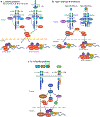Fine-Tuning Cytokine Signals
- PMID: 30649989
- PMCID: PMC10822674
- DOI: 10.1146/annurev-immunol-042718-041447
Fine-Tuning Cytokine Signals
Abstract
Cytokines are secreted or otherwise released polypeptide factors that exert autocrine and/or paracrine actions, with most cytokines acting in the immune and/or hematopoietic system. They are typically pleiotropic, controlling development, cell growth, survival, and/or differentiation. Correspondingly, cytokines are clinically important, and augmenting or attenuating cytokine signals can have deleterious or therapeutic effects. Besides physiological fine-tuning of cytokine signals, altering the nature or potency of the signal can be important in pathophysiological responses and can also provide novel therapeutic approaches. Here, we give an overview of cytokines, their signaling and actions, and the physiological mechanisms and pharmacologic strategies to fine-tune their actions. In particular, the differential utilization of STAT proteins by a single cytokine or by different cytokines and STAT dimerization versus tetramerization are physiological mechanisms of fine-tuning, whereas anticytokine and anticytokine receptor antibodies and cytokines with altered activities, including cytokine superagonists, partial agonists, and antagonists, represent new ways of fine-tuning cytokine signals.
Keywords: STAT protein; STAT tetramerization; cytokine; fine-tuning; partial agonist; superenhancers.
Figures




References
-
- Cohen S, Bigazzi PE, Yoshida T. 1974. Similarities of T cell function in cell-mediated immunity and antibody production. Cell Immunol. 12:150–59 - PubMed
-
- Leonard WJ. 2013. Type I cytokines and interferons, and their receptors. In Fundamental Immunology, ed. Paul WE, pp. 601–38. Philadelphia, PA: Wolters Kluwer Lippincott Williams Wilkins
-
- Milburn MV, Hassell AM, Lambert MH, Jordan SR, Proudfoot AE, et al. 1993. A novel dimer configuration revealed by the crystal structure at 2.4 A resolution of human interleukin-5. Nature 363:172–76 - PubMed
Publication types
MeSH terms
Substances
Grants and funding
LinkOut - more resources
Full Text Sources

